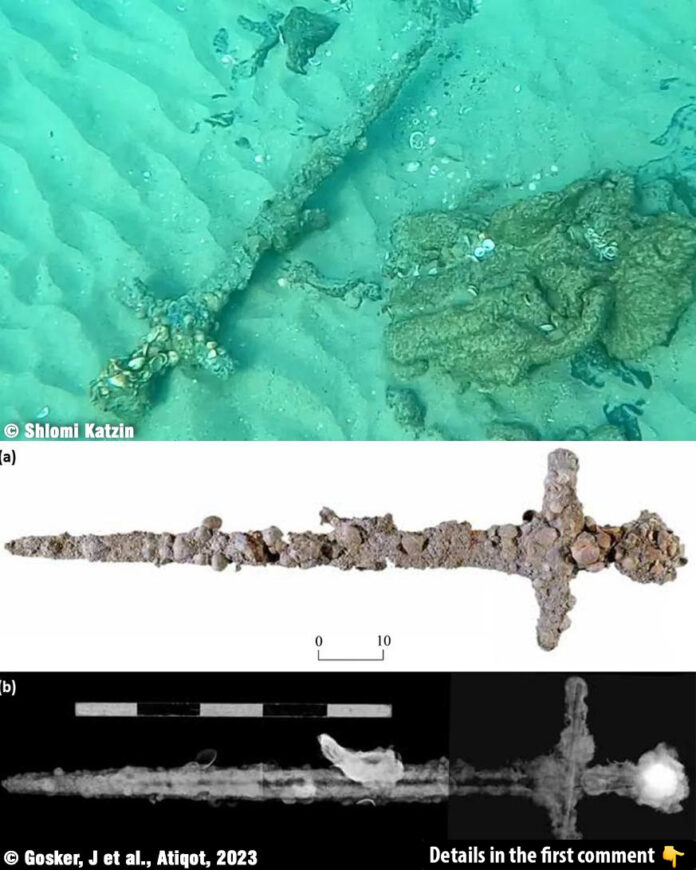In 2021, an 800-year-old Crusader sword, encrusted in marine concretion, was discovered off the coast of Neve Yam, Israel. This extraordinary relic offers a rare glimpse into the tumultuous battles of the Crusades, a series of religious wars that shaped the medieval world. Preserved beneath the shifting sands of the Mediterranean, this weapon stands as a testament to a bygone era of knights, naval skirmishes, and fierce confrontations.
The Discovery and Its Historical Context
The sword was uncovered by diver Shlomi Katzin during an underwater expedition. Concerned about looters, Katzin immediately handed over the artifact to the Israel Antiquities Authority (IAA). Found in a region rich with archaeological history, Neve Yam has served as a natural anchorage site for over 4,000 years, making it a treasure trove for marine archaeologists.
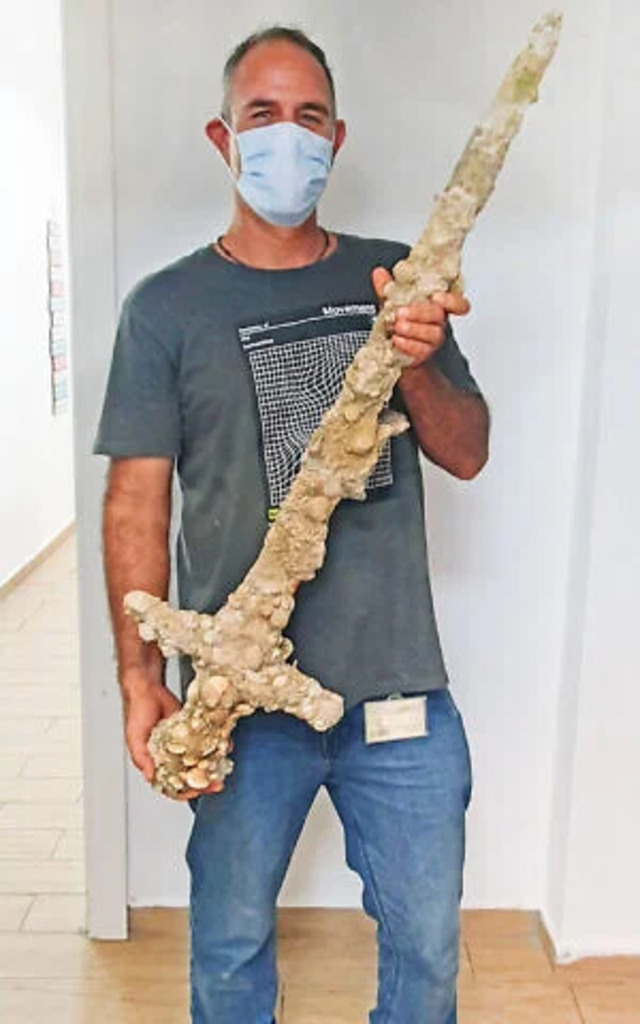
This particular find is significant because it offers direct evidence of the Crusader period in the Levant, which lasted from 1099, with the establishment of the Kingdom of Jerusalem, to 1291. During this time, naval battles were frequent as Crusaders and Muslim forces vied for control of key ports along the Mediterranean coast.
Video
An Israeli diver has found a 900-year-old crusader sword in perfect condition off the Mediterranean coast – watch the video to witness this extraordinary discovery and its historical significance!
A Closer Look at the Sword
The Neve-Yam sword is a classic example of a European medieval weapon. Measuring 88 centimeters (35 inches) in length and 4.6 centimeters (1.8 inches) in width, its long, straight blade was designed for both slashing and stabbing—ideal for close combat.
When the sword was discovered, it was encased in a thick layer of marine crust made of shells, sand, and hardened microorganisms. This natural coating, while making the sword difficult to study initially, also played a crucial role in its preservation. Without this protective layer, the iron blade would have likely disintegrated due to prolonged exposure to saltwater.
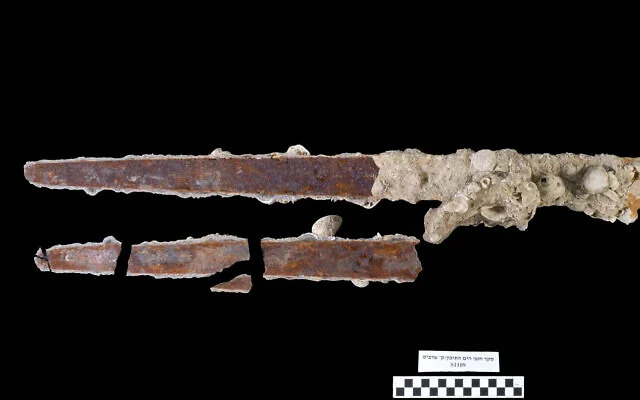
Challenges in Preservation and Research
Early attempts to study the sword revealed just how fragile it had become over centuries underwater. Initial efforts to remove the crust resulted in cracks, exposing and splitting parts of the blade. To prevent further damage, researchers turned to non-invasive techniques.
Using advanced X-ray radiography technology at the Soreq Nuclear Research Center, scientists were able to penetrate the crust and visualize the sword’s original shape. The imaging revealed a bent blade and a misaligned crossbar, strongly suggesting that the sword had been damaged during combat before it was lost to the sea.
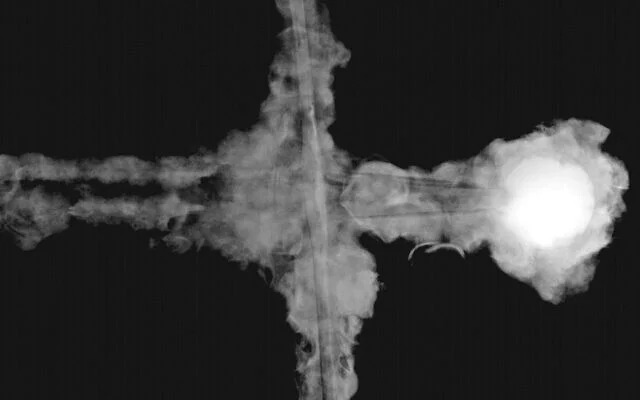
Insights into Crusader Warfare
The bent blade offers compelling evidence that the sword was likely lost during a fierce naval battle. Crusader swords were indispensable tools of war, wielded by knights and professional soldiers for face-to-face combat. These weapons were symbols of status, as their high cost and craftsmanship made them accessible only to the nobility and elite warriors.
The absence of a scabbard or sheath further supports the theory that the sword was dropped in the heat of battle. Swords were highly valued and rarely discarded unless damaged beyond repair or lost under dire circumstances. The fact that this weapon remained on the seabed for centuries underscores the chaos and unpredictability of medieval naval warfare.
The Rarity of Crusader Swords
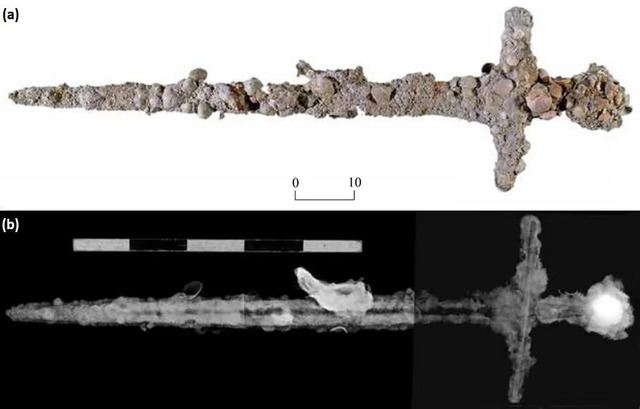
Finding a complete Crusader sword is an exceptionally rare occurrence. Historical records describe countless bloody battles between Crusaders and Muslims, yet intact swords from this era are seldom discovered. The scarcity is partly due to the practice of recycling iron—a precious material in the Middle Ages. Broken or outdated weapons were often melted down and repurposed into new tools or armaments.
In Israel, only seven Crusader swords have been unearthed to date, most of them recovered from the sea. The Neve-Yam sword stands out for its relatively well-preserved state and the context in which it was found, providing invaluable insights into the maritime conflicts of the period.
Linking the Sword to the Crusades
Experts believe that the sword belonged to a Crusader who participated in the First Crusade and settled in the newly established Kingdom of Jerusalem. During this time, the Crusaders relied heavily on maritime routes to maintain their supply lines and defend their territories. Ships from Italian city-states like Pisa and Venice played a pivotal role in attacking Muslim-controlled coastal cities.
The Neve-Yam region would have been a strategic location for such battles, serving as both a staging ground and a battleground for naval skirmishes. The sword’s discovery here aligns with historical accounts of Crusader activities along the Levantine coast, adding another layer of authenticity to its story.
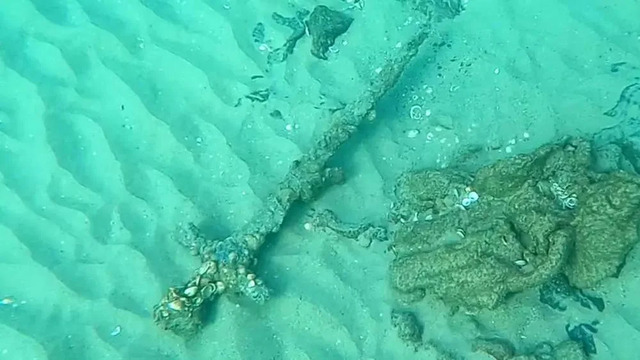
The Human Element Behind the Artifact
While the sword itself tells a compelling story, it also raises questions about the individual who wielded it. Was the warrior a noble knight, a seasoned soldier, or a young recruit fighting for faith and fortune? Although no human remains were found near the sword, researchers speculate that the warrior may still lie undiscovered in the depths, waiting to be revealed by the shifting sands.
The personal connection to this artifact is further highlighted by its craftsmanship. Swords were not just weapons; they were extensions of a knight’s identity and a symbol of their training, discipline, and social standing. Losing such a weapon in battle would have been a devastating blow, both practically and emotionally.
Broader Implications and Future Prospects
The Neve-Yam sword is more than just a relic; it is a window into the past. Its discovery underscores the importance of marine archaeology in uncovering hidden chapters of history. Each artifact recovered from the sea adds to our understanding of the complex dynamics of the Crusades, from the logistical challenges of naval warfare to the personal experiences of those who fought.
Looking ahead, the site around Neve Yam holds the potential for more discoveries. Advanced scanning technologies may yet reveal additional artifacts or even the remains of the sword’s owner. Such finds would deepen our knowledge of the period and provide further context for this remarkable weapon.
Conclusion
The discovery of the Neve-Yam sword is a poignant reminder of the enduring legacy of the Crusades. Preserved beneath the waves for centuries, it speaks to the bravery, conflict, and human drama of an era that shaped the medieval world. As researchers continue to study this artifact, it promises to shed new light on the lives and battles of those who wielded it. In doing so, the sword bridges the gap between history and modern archaeology, connecting us to a past that continues to captivate and inspire.
